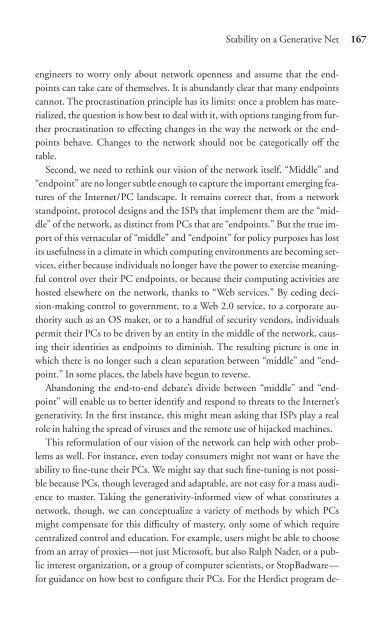Download - Future of the Internet â And how to stop it.
Download - Future of the Internet â And how to stop it.
Download - Future of the Internet â And how to stop it.
You also want an ePaper? Increase the reach of your titles
YUMPU automatically turns print PDFs into web optimized ePapers that Google loves.
Stabil<strong>it</strong>y on a Generative Net 167<br />
engineers <strong>to</strong> worry only about network openness and assume that <strong>the</strong> endpoints<br />
can take care <strong>of</strong> <strong>the</strong>mselves. It is abundantly clear that many endpoints<br />
cannot. The procrastination principle has <strong>it</strong>s lim<strong>it</strong>s: once a problem has materialized,<br />
<strong>the</strong> question is <strong>how</strong> best <strong>to</strong> deal w<strong>it</strong>h <strong>it</strong>, w<strong>it</strong>h options ranging from fur<strong>the</strong>r<br />
procrastination <strong>to</strong> effecting changes in <strong>the</strong> way <strong>the</strong> network or <strong>the</strong> endpoints<br />
behave. Changes <strong>to</strong> <strong>the</strong> network should not be categorically <strong>of</strong>f <strong>the</strong><br />
table.<br />
Second, we need <strong>to</strong> rethink our vision <strong>of</strong> <strong>the</strong> network <strong>it</strong>self. “Middle” and<br />
“endpoint” are no longer subtle enough <strong>to</strong> capture <strong>the</strong> important emerging features<br />
<strong>of</strong> <strong>the</strong> <strong>Internet</strong>/PC landscape. It remains correct that, from a network<br />
standpoint, pro<strong>to</strong>col designs and <strong>the</strong> ISPs that implement <strong>the</strong>m are <strong>the</strong> “middle”<br />
<strong>of</strong> <strong>the</strong> network, as distinct from PCs that are “endpoints.” But <strong>the</strong> true import<br />
<strong>of</strong> this vernacular <strong>of</strong> “middle” and “endpoint” for policy purposes has lost<br />
<strong>it</strong>s usefulness in a climate in which computing environments are becoming services,<br />
ei<strong>the</strong>r because individuals no longer have <strong>the</strong> power <strong>to</strong> exercise meaningful<br />
control over <strong>the</strong>ir PC endpoints, or because <strong>the</strong>ir computing activ<strong>it</strong>ies are<br />
hosted elsewhere on <strong>the</strong> network, thanks <strong>to</strong> “Web services.” By ceding decision-making<br />
control <strong>to</strong> government, <strong>to</strong> a Web 2.0 service, <strong>to</strong> a corporate author<strong>it</strong>y<br />
such as an OS maker, or <strong>to</strong> a handful <strong>of</strong> secur<strong>it</strong>y vendors, individuals<br />
perm<strong>it</strong> <strong>the</strong>ir PCs <strong>to</strong> be driven by an ent<strong>it</strong>y in <strong>the</strong> middle <strong>of</strong> <strong>the</strong> network, causing<br />
<strong>the</strong>ir ident<strong>it</strong>ies as endpoints <strong>to</strong> diminish. The resulting picture is one in<br />
which <strong>the</strong>re is no longer such a clean separation between “middle” and “endpoint.”<br />
In some places, <strong>the</strong> labels have begun <strong>to</strong> reverse.<br />
Abandoning <strong>the</strong> end-<strong>to</strong>-end debate’s divide between “middle” and “endpoint”<br />
will enable us <strong>to</strong> better identify and respond <strong>to</strong> threats <strong>to</strong> <strong>the</strong> <strong>Internet</strong>’s<br />
generativ<strong>it</strong>y. In <strong>the</strong> first instance, this might mean asking that ISPs play a real<br />
role in halting <strong>the</strong> spread <strong>of</strong> viruses and <strong>the</strong> remote use <strong>of</strong> hijacked machines.<br />
This reformulation <strong>of</strong> our vision <strong>of</strong> <strong>the</strong> network can help w<strong>it</strong>h o<strong>the</strong>r problems<br />
as well. For instance, even <strong>to</strong>day consumers might not want or have <strong>the</strong><br />
abil<strong>it</strong>y <strong>to</strong> fine-tune <strong>the</strong>ir PCs. We might say that such fine-tuning is not possible<br />
because PCs, though leveraged and adaptable, are not easy for a mass audience<br />
<strong>to</strong> master. Taking <strong>the</strong> generativ<strong>it</strong>y-informed view <strong>of</strong> what const<strong>it</strong>utes a<br />
network, though, we can conceptualize a variety <strong>of</strong> methods by which PCs<br />
might compensate for this difficulty <strong>of</strong> mastery, only some <strong>of</strong> which require<br />
centralized control and education. For example, users might be able <strong>to</strong> choose<br />
from an array <strong>of</strong> proxies—not just Micros<strong>of</strong>t, but also Ralph Nader, or a public<br />
interest organization, or a group <strong>of</strong> computer scientists, or S<strong>to</strong>pBadware—<br />
for guidance on <strong>how</strong> best <strong>to</strong> configure <strong>the</strong>ir PCs. For <strong>the</strong> Herdict program de-


